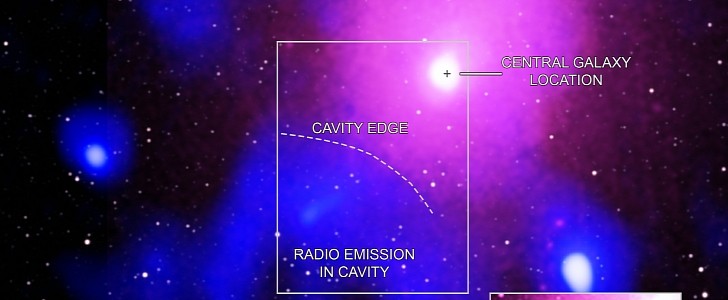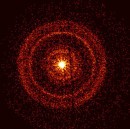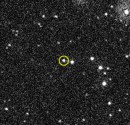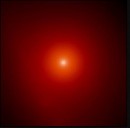The great celebrity theoretical physicist Michio Kaku once famously quipped that he turned down several offers from military-industrial companies who wanted him to come work on nuclear weapons programs. He says he snarkily replied that he wanted to focus on far grander explosions.
Well, does the brightest, most intense explosion ever recorded by NASA fit the bill? It's the most luminescent incident you're bound to observe in the universe this side of the Big Bang. According to data from the Neil Gehrels Swift Observatory, the Fermi Gamma-ray Space Telescope, and the Wind spacecraft, something off in distant space has gone kaboom to a truly biblical degree.
More specifically, a far-off, distant star collapsed in on itself sometime far off in the distant past. The immense level of light emitted from this distant solar system's awesomely violent death is only now reaching distances visible by modern space telescopes.
What they're finding is nothing short of mind-meltingly astonishing. The star in question is dubbed GRB 221009A. It rolls right off the tongue, doesn't it? Jokes aside, it didn't take gamma-ray observatories and telescopes across the globe long to realize something amazing was happening.
It's not often a flash of shockingly bright light and energy suddenly pops up in the night sky so intense it mimics a star many times closer than it actually is. That'd be 1.9 billion light years in the case of this dead star. It's generally agreed that not every star in the cosmos will go supernova. Most of them will merely fizzle into White Dwarfs and eventually Black Dwarfs. But stars with masses multiple times as large as that of our Sun behave particularly unpredictably as they begin to exhaust their supplies of hydrogen, which can fuse into helium.
At this point, the star will begin to try and fuse helium with other elements like oxygen, iron, nickel, and carbon. Once it starts trying to fuse large quantities of carbon, the reaction starts to fail. When the level of nuclear energy emitted decreases compared to the force of gravity, things start to go haywire extremely quickly. Couple that with that mass of ten or more suns pressing in on the star's core, and it shouldn't be too hard to realize what's about to happen.
The results quite literally bend the fabric of spacetime pushes the laws of physics to their extremes. Perhaps the only force preventing this explosion from reaching Earth any faster is the hard upper limit of light speed. But in terms of scientific study, this explosion couldn't have been recorded at a better time.
Not only was a whole suite of space telescopes specialized in broad energy spectrums focused on it, but so was NASA's NICER X-ray telescope aboard the International Space Station. Meaning human eyes were able to view data in real-time in Low Earth Orbit (LEO).
According to direct NASA reports, the Fermi telescope's sensors focused directly on the exploding star for ten straight hours. "This burst is much closer than typical GRBs, which is exciting because it allows us to detect many details that otherwise would be too faint to see," said Roberta Pillera of the Fermi LAT Collaboration. "It's also among the most energetic and luminous bursts ever seen regardless of distance, making it doubly exciting."
For all we've learned about this most recent supernova so far, it, of course, leaves more questions than answers. Was there a solar system around this star when it collapsed in on itself? And if so, is there anything left behind? Is there a bloodthirsty black hole residing where said star used to be?
These are all things scientists in space and on Earth are attempting to figure out at this very moment. What they uncover could change our understanding of how stars live, but also how they die.
More specifically, a far-off, distant star collapsed in on itself sometime far off in the distant past. The immense level of light emitted from this distant solar system's awesomely violent death is only now reaching distances visible by modern space telescopes.
What they're finding is nothing short of mind-meltingly astonishing. The star in question is dubbed GRB 221009A. It rolls right off the tongue, doesn't it? Jokes aside, it didn't take gamma-ray observatories and telescopes across the globe long to realize something amazing was happening.
It's not often a flash of shockingly bright light and energy suddenly pops up in the night sky so intense it mimics a star many times closer than it actually is. That'd be 1.9 billion light years in the case of this dead star. It's generally agreed that not every star in the cosmos will go supernova. Most of them will merely fizzle into White Dwarfs and eventually Black Dwarfs. But stars with masses multiple times as large as that of our Sun behave particularly unpredictably as they begin to exhaust their supplies of hydrogen, which can fuse into helium.
The results quite literally bend the fabric of spacetime pushes the laws of physics to their extremes. Perhaps the only force preventing this explosion from reaching Earth any faster is the hard upper limit of light speed. But in terms of scientific study, this explosion couldn't have been recorded at a better time.
Not only was a whole suite of space telescopes specialized in broad energy spectrums focused on it, but so was NASA's NICER X-ray telescope aboard the International Space Station. Meaning human eyes were able to view data in real-time in Low Earth Orbit (LEO).
According to direct NASA reports, the Fermi telescope's sensors focused directly on the exploding star for ten straight hours. "This burst is much closer than typical GRBs, which is exciting because it allows us to detect many details that otherwise would be too faint to see," said Roberta Pillera of the Fermi LAT Collaboration. "It's also among the most energetic and luminous bursts ever seen regardless of distance, making it doubly exciting."
These are all things scientists in space and on Earth are attempting to figure out at this very moment. What they uncover could change our understanding of how stars live, but also how they die.






